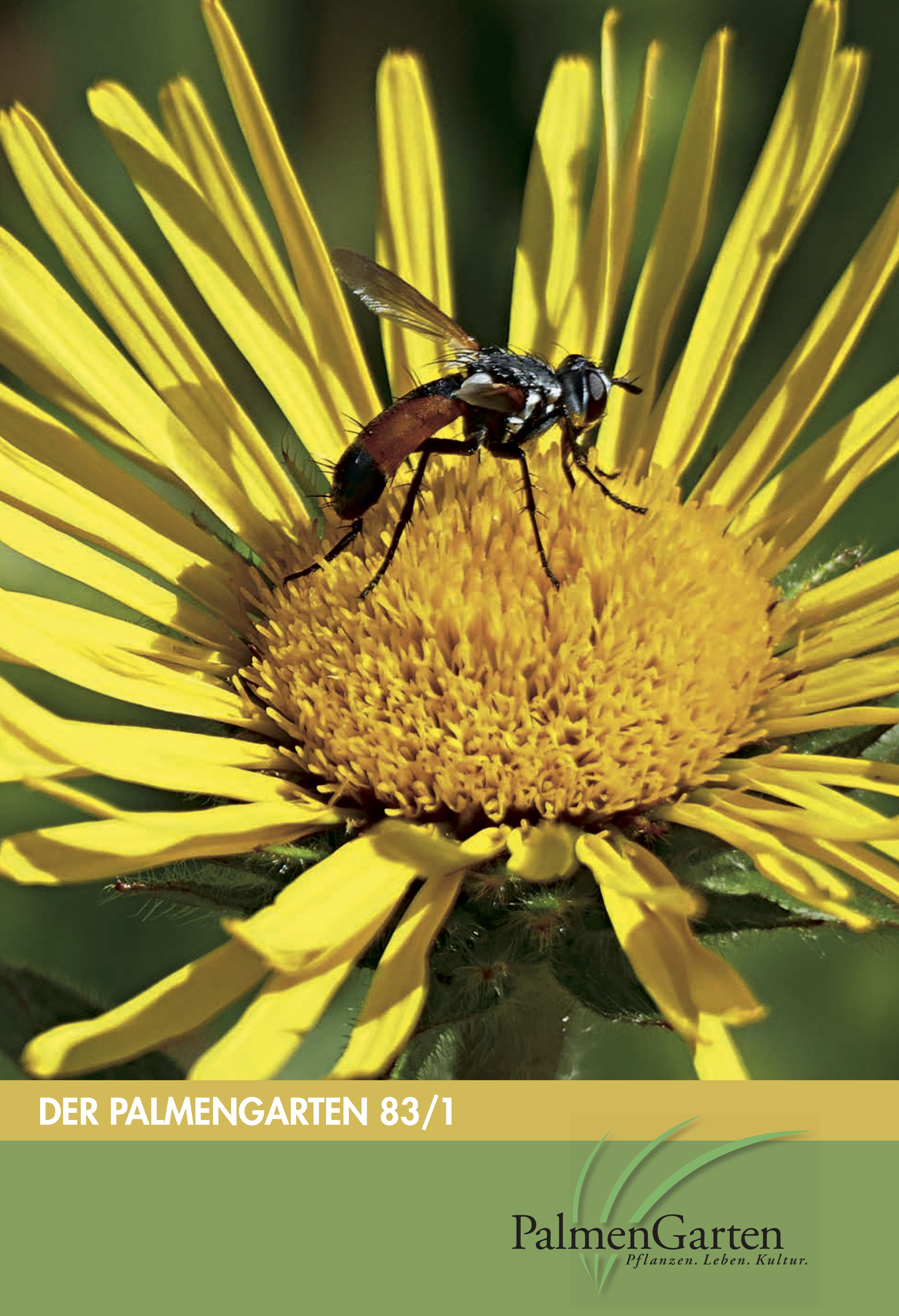Die großen wissenschaftlichen Leistungen von Stefan Vogel (1925–2015) Teil 5c. Öl statt Nektar– die Ölblumen (monokotyle Vertreter und abschließende Bemerkungen)
DOI:
https://doi.org/10.21248/palmengarten.497Abstract
Bei den Monokotyledonen haben sich Ölblumen in zwei Familien entwickelt: Iridaceen und Orchideen. Bei ersteren (mit Trichom-Elaiophoren) zweimal, bei letzteren mindestens 10 mal voneinander unabhängig (sowohl Trichom- als auch Epithel-Elaiophoren). Wichtige Vertreter aus beiden Familien, die bereits von Stefan Vogel entdeckt wurden, werden näher dargestellt und illustriert. Abschließend werden folgende Aspekte der Ölblumen angesprochen: Pflanzengeographie, Evolution und sekundärer Verlust der floralen Ölproduktion, Mimikry und Voraussage in der Wissenschaft.
Literaturhinweise
Chase, M. W., Williams, N. H., Neubig, K. M. & Whitten, W. M. 2008: Taxonomic transfers in Oncidiinae to accord with Genera Orchidacearum, vol. 5. – Lindleyana 21: 20-31.
Cingel, N. A. van der 2001: An atlas of orchid pollination – America, Africa, Asia and Australia. – Rotterdam.
Darwin, C. R. 1862: On the various contrivances by which British and foreign orchids are fertilised by insects, and on the good effects of intercrossing. – London – Deutsche Übersetzung (durch H. G. Bronn): Über die Einrichtungen zur Befruchtung Britischer und ausländischer Orchideen durch Insekten und über die günstigen Erfolge der Wechselbefruchtung. – Stuttgart: Schweizerbart. Online-Zugang: https://www. biodiversitylibrary.org/item/52809#page/11/mode/1up
Davis, C. C. & Anderson, W. R. 2010: A complete generic phylogeny of Malpighiaceae inferred from nucleotide sequence data and morphology. – Amer. J. Bot. 97: 2031-2048. https://doi.org/10.3732/ajb.1000146
Dötterl, S., Gerlach, G. & Weber, A. 2018: Die großen wissenschaftlichen Leistungen von Stefan Vogel (1925- 2015). Teil 5b. Öl statt Nektar – die Ölblumen (dikotyle Vertreter). – Palmengarten 82 (2): 48-65. https://doi.org/10.21248/palmengarten.482
Goldblatt, P. & Manning, J. C. 2006: Radiation of pollination systems in the Iridaceae of sub-Saharan Africa. – Ann. Bot. 97: 317-344. https://doi.org/10.21248/palmengarten.482
Johnson, S. D. & Wester, P., 2017: Stefan Vogel’s analysis of floral syndromes in the South African flora: an appraisal based on 60 years of pollination studies. – Flora 232: 200-206. https://doi.org/10.1016/j.flora.2017.02.005
Manning, J. C. & Goldblatt, P. 2005: Radiation of pollination systems in the Cape genus Tritoniopsis (Iridaceae: Crocoideae) and the development of bimodal pollination strategies. – Int. J. Plant Sci. 166:459-474. https://doi.org/10.1086/428703
Manning, J. C. & Goldblatt, P. & Frills, I. 2002: The pollination of Tritoniopsis parviflora (Iridaceae) by the oil-collecting bee Rediviva gigas (Hymenoptera: Melittidae): the first record of oil-secretion in African Iridaceae. – South African J. Bot. 68: 171-176. https://doi.org/10.1016/s0254-6299(15)30416-6
Neubig, K. M., Whitten, W. M., Williams N., Blanco, M. A. Endara, L., Burleigh, J. G., Silvera, K., Cushman, J. C. & Chase, M. W. 2012: Generic recircumscriptions of Oncidiinae (Orchidaceae: Cymbidieae) based on maximum likelihood analysis of combined DNA datasets. – Bot. J. Linn. Soc. 168: 117-146. https://doi.org/10.1111/j.1095-8339.2011.01194.x
Pauw, A. 2006: Floral syndromes accurately predict pollination by a specialized oil-collecting bee (Rediviva peringueyi, Melittidae) in a guild of South African orchids. – Amer. J. Bot. 93: 917-926. https://doi.org/10.3732/ajb.93.6.917
Pijl, L. van der & Dodson, C. H. 1966: Orchid flowers: their pollination and evolution. – Coral Gables, FL. Renner, S. S. & Schaefer, H. 2010: The evolution and loss of oil-offering flowers – new insights from dated phylogenies for angiosperms and bees. – Phil. Trans. Roy. Soc. B 365: 423-135. https://doi.org/10.1098/rstb.2009.0229
Steiner, K. E. & Whitehead, V. B. 1990: Pollinator adaptation to oil-secreting flowers – Rediviva and Diascia. – Evolution 44: 1701-1707. https://doi.org/10.1111/j.1558-5646.1990.tb03857.x
Steiner, K. E. 1989: The pollination of Disperis (Orchidaceae) by oil-collecting bees in southern Africa. – Lindleyana 4: 164-183.
Steiner, K. E. 1998: The evolution of beetle pollination in a South African orchid. – Amer. J. Bot. 85: 1180-1193. https://doi.org/10.2307/2446351
Steiner, K. E. & Whitehead, V. B. 1988: The association between oil-producing flowers and oil-collecting bees in the Drakensberg of Southern Africa. – Monogr. Syst. Bot. Missouri Bot. Gard. 25: 259-277.
Vogel S. 1954: Blütenbiologische Typen als Elemente der Sippengliederung, dargestellt anhand der Flora Südafrikas. — Bot. Studien, Heft 1: 1-338. Jena.
Vogel S. 1974: Ölblumen und ölsammelnde Bienen. – Abh. Akad. Wiss. Lit. Mainz, Math.-Naturwiss. Kl. 7: 285-547. Wiesbaden.
Vogel S. 1984: The Diascia flower and its bee: an oil-based symbiosis in Southern Africa. – Acta Bot. Neerl. 33: 509-518. https://doi.org/10.1111/j.1438-8677.1984.tb01842.x
Vogel S. 1990: History of the Malpighiaceae in the light of pollination ecology. – Mem. New York Bot. Gard. 55: 130-142.
Vogel S. 1993: Betrug bei Pflanzen: Die Täuschblumen. – Abh. Akad. Wiss. Lit. Mainz, Math.-Naturwiss. Kl. 1993: 1-48.
Vogel S. & Michener, C. D. (1985): Long bee legs and oil producing floral spurs, and a new Rediviva (Hymenoptera, Melittidae; Scrophulariaceae). – J. Kansas Entomol. Soc. 58: 359-364.




